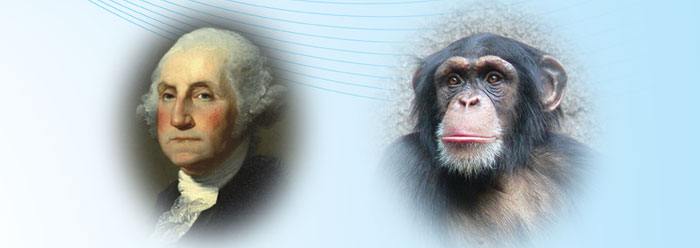“I’m related to George Washington,” an acquaintance announced after searching his genealogical record. He also believes he is closely related to chimpanzees. Though he doesn’t really look like either, all three do share a lot of similar features.
So, are similar looks or features enough to establish whether these three are related closely, remotely, or not at all in regard to their ancestry? No. Similar looks and features can be very deceiving. A true relationship is actually a fact-based connection. A line of connected birth certificates is factual evidence that can be verified. Just comparing similar features—or even DNA—to determine related ancestry is always an inference with a probability of being right ranging from high to zero.
If all organisms had completely different features, there might not be any discussion of them being related by common descent. However, evolutionists have effectively sold the idea that when people see similarities, they actually “see” remnants of common ancestry. Seeing something carries emotional links. So persuading an evolutionist, who feels deep down inside that all life is somehow connected, to replace his inference-based account of similarities with a design-based explanation is challenging.
The good news is the Bible’s assurance that the Lord’s designs in nature are “clearly seen” (Romans 1:20), which means that His creative witness has real power to cause blinded minds (2 Corinthians 4:4) to see truth.
Homology: Another Circular Evolutionary Concept
Related—a word that could mean sharing common attributes or common ancestry. Cataloging common attributes is generally objective scientific inquiry, but explaining their origin through common ancestry is subjective. Before Darwin, the common attributes shared by different types of, say, fish or birds were useful for classifying the living things of nature. But they were only that—common attributes.
When discussing the similar features of organisms with friends, it is important to first point out that all that can be definitively claimed about them scientifically is that they are similar—which may or may not be relevant. Be prepared to avoid getting sidetracked and stay on topic. The issues are explaining where structures originally come from, and whether there is a scientifically plausible mechanism that can change one kind of creature into a fundamentally different kind of creature.
Next, point out that for Darwin and his followers, it is only self evidence that similar features are explained by common descent. For them, this is an axiom—an obvious truth—not needing outside experimental validation. In 1859, Darwin’s explanation was more like dogma: “The similar framework of bones in the hand of a man, wing of a bat, fin of the porpoise, and leg of the horse…and innumerable other such facts, at once explain themselves on the theory of descent with slow and slight successive modification.”1 In even today’s best scientific journals, the treatment is unchanged. Thus, common ancestry is the explanation for common attributes and common attributes are the evidence of common ancestry.
Just like “natural selection” and “survival of the fittest,” common ancestry is the self-apparent explanation for common features only because the thinking is circular. Circular arguments are naturally self-certifying. In this case, circularity has even advanced to the point of definition: “Although ancestry was at first viewed only as an explanation for homology [similar features], it soon was incorporated into the definition.”2
Similar Features Mean Common Ancestry…Except When They Don’t
“Inconsistent” is the best word to stress in conversations to describe how evolutionists compare similar features among organisms. This is because similar features are just that—similar—and the myriad of combinations that organisms possess does not necessarily fit branching evolutionary trees. If evolutionists believe a similar feature is from a common ancestor, it is due to “divergent evolution.” And if organisms share a similar feature not due to common ancestry, it is conveniently called “convergent evolution.”
Scientific-sounding lingo is substituted for data to explain why organisms with essentially no common ancestry have extraordinarily similar features, like the camera-like eye shared by squids and humans. At the same time, other facts are selectively deemphasized about organisms that are presumed to be very closely related and yet do not share some surprisingly important features, such as humans having a muscle that moves the thumb’s tip that chimpanzees don’t have.
The main point is that explanations for the presence or absence of similar features are totally arbitrary. For example, evolutionists assert that whales’ distinctive body shape evolved from a lineage of land mammals that slowly readapted to aquatic life. Consider how the leading journal Science elected to pick-and-choose between conflicting features, either molecular or shapes of parts (called “morphology”), to support this theory:
Despite this evidence that cetaceans [whales] evolved from artiodactyls [even-toed mammals like deer, sheep, and pigs], substantial discrepancies remain. If cetaceans belong to artiodactyls, then similarities in the cranial and dental morphologies of mesonychians [extinct carnivorous mammals] and cetaceans must be a result of convergent evolution or must have been lost in artiodactyls. Furthermore, molecular data favor a sister-group relationship between whales and hippopotami. This conflicts with the conventional view based on morphology that hippopotami are closer to other artiodactyls than they are to whales.3
If features do not conform to preconceived thinking, that is because they could represent “divergence,” “convergence,” “character reversals,” “vestiges,” “rudiments,” “independent losses,” “one-time gains,” “parallel derivatives,” or any of the jargon tagged to subjective evolutionary explanations. Comparing fossils based on similar features suffers from the same trap of circular reasoning, and gene sequence comparisons suffer from the same prejudices, inconsistencies, and excuses. In fact, comparing different sequences from the same organism can lead to very different presumed evolutionary relationships. These facts provide a conversational opportunity to highlight the plasticlike attribute of evolutionary theory to absorb all observations—even ones that are totally contradictory.
Learning a Short Example
Do evolutionists really approach similar features inconsistently? Consider a report on genetic research for the trait of echolocation:
The discovery represents an unprecedented example of adaptive sequence convergence between two highly divergent groups....[Study author Stephen Rossiter stated] “it is generally assumed that most of these so-called convergent traits have arisen by different genes or different mutations. Our study shows that a complex trait—echolocation—has in fact evolved by identical genetic changes in bats and dolphins.”… [I]f you draw a phylogenetic [relationship] tree...based on similarities in the prestin [a hearing gene] sequence alone, the echolocating bats and whales come out together rather than with their rightful evolutionary cousins….[Rossiter added], “We were surprised by...the sheer number of convergent changes in the coding DNA.”4
So, based on conflicting similarities in shapes of body parts, fossils, or genes, are deer, sheep, pigs, extinct wolf-like animals, hippopotami, or bats the bona fide “rightful evolutionary cousins” of whales? Also note how the gene sequence similarities—which have nothing to do with common ancestry—are utterly dismissed as a simple convergence of fortuitous mutations.
Pulling It All Together
Armed with facts, believers can provide open-minded listeners with information regarding similar features that they will never get from evolution-based textbooks, teachers, or television. A brief conversation may go something like this:
Granted, humans do look more like chimpanzees than horses. That is why evolutionists regularly claim that we are cousins. Similar features are probably the best evidence for evolution, but they really turn out to be a big problem. First, only focusing on similar features sidetracks discussion from the main issue evolutionists have failed to explain, which is where the complex information and molecular construction machinery to make any feature on any creature originated. Simply claiming that they got it from their “older relative” begs the question and is not an explanation. This leads to the next problem.
Evolutionists assert the self-evidence that similar features show relationships. By assuming the truth of a claim that they should be proving, evolutionists end up in this inescapable tangle of circular thinking: Similar features are derived from common ancestry and the best evidence for common ancestry is similar features. Darwin disregarded the circularity of his argument, just as his followers do today.
Even more revealing is that evolutionists never tell us that there really are not tidy, logical threads of traits from a common ancestor down all the paths to different types of creatures—forcing them to pick and choose which traits to showcase or to make excuses. In truth, creatures share some traits with other creatures—“related” or not. Comparing organisms’ traits actually shows patchwork similarity. That is why humans have some traits that are similar to chimpanzees, but other traits just as—or more—similar to orangutans, gibbons, guinea pigs, other animals, and even plants.
Given the failure of evolution to prove you are related to chimpanzees, shouldn’t you consider starting a worthwhile relationship with your Creator, the Lord Jesus Christ? For those related to Him by faith, He prayed, “Father, I will that they also, whom thou hast given me, be with me where I am; that they may behold my glory” (John 17:24).
References
- Darwin, C. 1872. The Origin of Species By Means of Natural Selection, 6th ed. London: John Murray, 420, emphasis added.
- Donoghue, M. 1992. Homology. In Keywords in Evolutionary Biology. Keller, E. F. and E. A. Lloyd, eds. Cambridge, MA: Harvard University Press, 171.
- Rose, K. D. 2001. Evolution: The Ancestry of Whales. Science. 293 (5538): 2216-2217.
- In Bats and Whales, Convergence in Echolocation Ability Runs Deep. ScienceDaily. Posted on sciencedaily.com, accessed August 10, 2010. A report on research published in Current Biology.
* Dr. Guliuzza is ICR’s National Representative.
Cite this article: Guliuzza, R. 2010. Similar Features Show Design, Not Universal Common Descent. Acts & Facts. 39 (10): 10-11.











